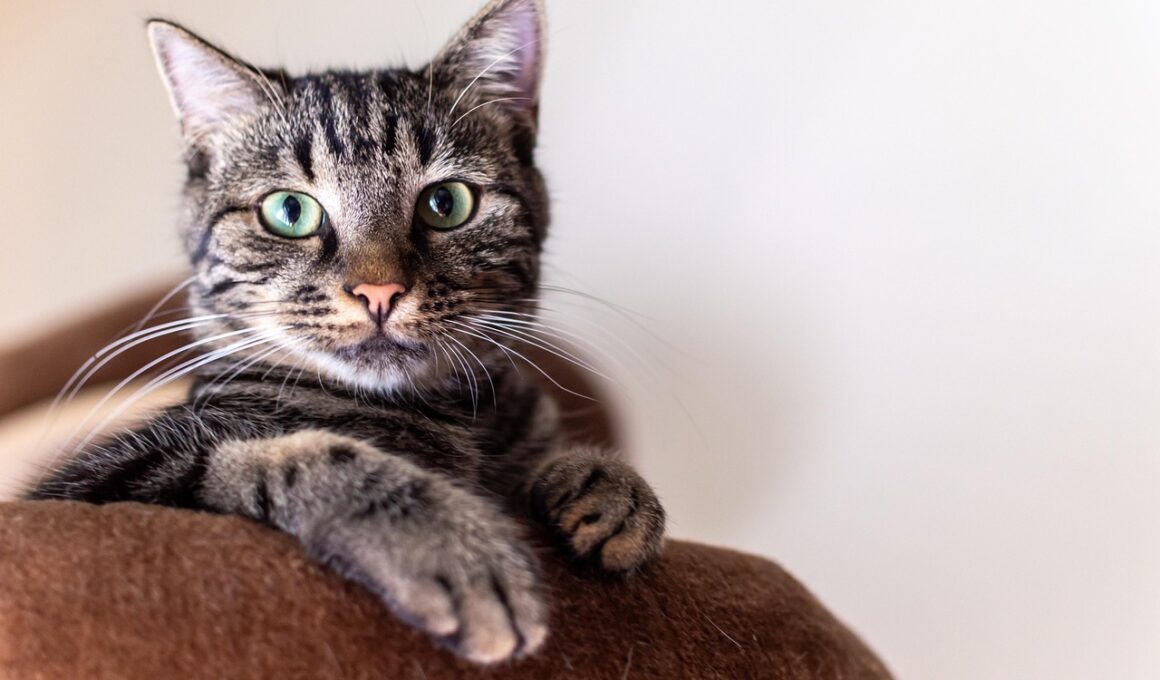Effective Exercise Techniques to Reduce Stress in Cats
Understanding cat behavior is essential for maintaining a healthy and stress-free environment for your feline friend. Cats are inherently playful, and providing them with appropriate exercise is vital for their mental well-being. Engaging your cat in physical activity helps alleviate stress and promotes a happier disposition. Among various exercise methods, interactive play is one of the most effective. Using toys like feather wands or laser pointers can stimulate their natural hunting instincts, allowing them to express their playful behavior. Additionally, ensuring a safe space where they can freely move can encourage them to explore their surroundings, which is beneficial for their physical health and mental stimulation. You may also consider incorporating climbing shelves or cat trees, which can provide cats with a landscape to conquer and explore. These structures not only serve as exercise equipment but also give them a sense of security, reducing anxiety levels in the household. Overall, exercise is crucial in helping your cat release pent-up energy while reducing stress significantly. It is an essential component of their overall well-being and happiness.
In addition to interactive play, another effective technique for reducing stress is engaging cats in play sessions with puzzle toys. Such toys can stimulate their minds while keeping them physically active. These toys often come with small compartments to hide treats or kibble, compelling your cat to think critically to access their rewards. This type of engagement can prevent boredom, which is often a precursor to stress. You can also monitor your cat’s responses to various puzzle toys to determine which captures their attention the most. Regularly rotating toys keeps the experience exciting for your pet. Furthermore, you can encourage your cat to participate in gentle indoor exercises, such as fetch. Surprisingly, many cats enjoy chasing and returning objects. Start by tossing a lightweight toy across the room and encouraging your feline to retrieve it. Gradually expand the distance as they become more confident. Outdoor activities, when safe, also provide significant benefits. Supervised time in a secure garden or on a leash introduces them to natural elements, often relieving anxiety and offering an enriching experience.
Creating a Cat-Friendly Environment
Creating an enriching environment is crucial for reducing stress in cats. Incorporating various forms of stimulation, such as climbing structures, scratch posts, and cozy hideaways, can vastly improve their daily lives. Cats are naturally curious and enjoy vertical spaces; a well-structured environment allows for exploration and adventure. To ensure your cat achieves optimal physical fitness, consider the layout of your home. Place toys within their reach and also create pathways that encourage movement. Reduce clutter and provide clear routes for them to traverse. You can also add scents by incorporating catnip or mint plants to engage their senses. A calming aroma can help relax them in times of stress, creating a sense of security. Additionally, maintain a regular schedule for feeding and playtime to instill a routine. Cats thrive on predictability, and knowing what to expect can alleviate anxiety. It’s also beneficial to observe your cat’s interaction with their environment and make necessary adjustments based on their preferences, ensuring they feel safe and engaged with their surroundings.
Training your cat can also serve as an exercise technique that promotes bonding and mental stimulation. Positive reinforcement is effective in teaching your cat commands or tricks, ensuring that both of you enjoy the experience. Start with simple commands like ‘sit’ or ‘high-five.’ Use treats as rewards for successful attempts. This process can strengthen your bond while offering your pet much-needed physical engagement. Furthermore, training sessions also stimulate your cat’s mind, making them more adaptable in daily routines. Consider introducing short sessions in various locations to keep the environment engaging. You could also implement a reward system for desired behaviors, reinforcing positive actions and minimizing stress. Gradually increase the difficulty of tasks during training to keep your cat mentally agile and engaged. Remember to provide plenty of praise and affection as reassurance whenever they succeed. This combination of praise and reward helps create a positive feedback loop. Proper training not only supports physical fitness but also nurtures their emotional health, ultimately reducing stress levels.
The Role of Diet in Stress Management
The right diet plays a crucial role in a cat’s overall personality and stress levels. Proper nutrition can greatly influence their mood and behavior. Feeding your cat high-quality food that meets their nutritional needs stabilizes energy levels, positively affecting their overall demeanor. It’s important to consult your vet to determine your cat’s dietary requirements. An appropriate balance of protein, healthy fats, and fibers contributes to their health and vitality. Moreover, while engaging them in physical exercise, be mindful of their calorie intake to maintain a healthy weight. Regular feeding schedules also contribute to their sense of security. Avoid sudden dietary changes, as they can cause gastrointestinal distress and lead to increased anxiety levels in cats. Always introduce new foods gradually and watch for any adverse reactions. Some owners find success incorporating calming supplements specifically formulated for cats, which can ease stress during stressful periods like moving homes or dealing with new family members. Overall, a balanced diet paired with adequate exercise significantly enhances your cat’s stress-free lifestyle.
Regular veterinary check-ups also play an essential role in managing your cat’s stress. Cats may sometimes exhibit stress-related behaviors due to underlying health issues that need addressing. Consistently monitoring their physical health ensures early detection and treatment, minimizing anxiety induced by illness. If your pet displays changes in behavior, heavy vocalizations, or withdrawal, seek professional advice immediately. Alongside Routine check-ups, don’t hesitate to discuss behavioral concerns with your veterinarian. They may recommend specific exercise routines, supplements, or therapy tailored to your cat’s individual needs. Scheduling regular blood tests can track any significant health changes that can indirectly influence stress levels. Moreover, consider pet insurance to cushion unexpected health-related expenses, allowing you to focus on providing a nurturing environment. The peace of mind that comes from knowing your cat is healthy will also reflect positively on theirs’ mental state. By maintaining their physical health, you contribute to their emotional well-being, ensuring they feel safe and relaxed at home.
Conclusion
In conclusion, reducing stress in cats involves a multifaceted approach focusing on exercise, training, diet, and health management. Engaging cats in rewarding play, creating enriching environments, and establishing routines are effective strategies to alleviate anxiety in your feline companions. Regular exercise helps maintain optimal physical and mental health, positively influencing their mood and behavior. Furthermore, ensuring a nutritious diet, along with continuous health monitoring, reinforces a stress-free lifestyle. Understanding your cat’s needs and preferences allows you to tailor activities that keep them engaged and happy. Apply positive reinforcement in training to foster strong bonds while promoting mental stimulation. Always consult your veterinarian regarding any sudden behavior changes or health concerns, ensuring your pet receives necessary care. The goal is not just to reduce stress but to cultivate a thriving, joyous atmosphere for your cat to flourish. Remember, a happy cat leads to a happy home, enhancing the overall quality of life for both pets and owners alike. Investing time in your cat’s well-being will reward you with the companionship of a playful, energetic, and healthy pet.



